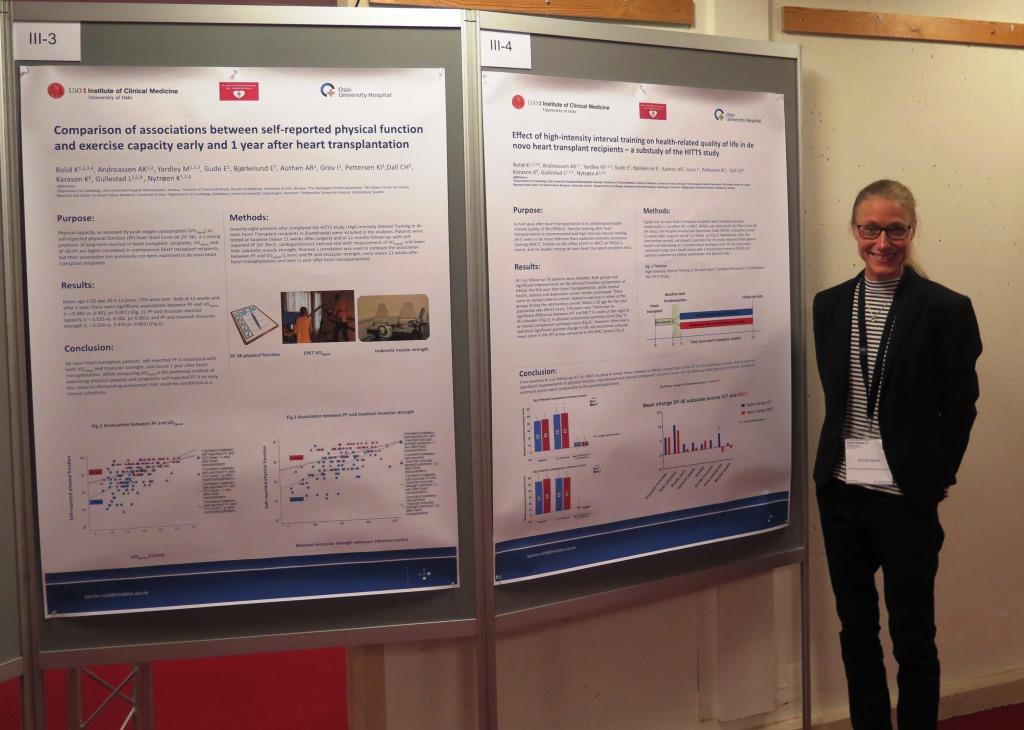18th Annual CHFR Symposium on Heart Research
The Center for Heart Failure Research (CHFR) was established in 2002 and has since then promoted the integration of high quality research from bench to bedside. Center members have a broad range of expertise, covering state-of-the-art gene technology, protein function, integrative physiology in pathophysiological models and clinical studies. This collective knowledge and active research collaboration has resulted in more than 200 scientific publications each year.
Several members of the Clinical cardiology research group presented the latest results from their studies.
Among them Gunn Marit Traaen & co with the poster "Prevalence and clinical predictors of sleep apnea in patients with paroxysmal atrial fibrillation" indicating that sleep apnea (SA) might be under-recognized in patients with atrial fibrillation (AF).
Katrine Rolid presented two posters this year "Comparison of associations between self-reported physical function and exercise capacity early and one year after heart transplantation" and "Effect of high intensity interval training on health related quality of life in de novo heart transplant recipients – a substudy of the HITTS study".
Winning the best poster prize in the second session was Karoline Bjarnesdatter Rypdal with her poster “The secreted cardiac fibroblast glycoprotein ADAMTSL2 is up-regulated in heart failure and directs anti-fibrotic signaling”.
The second session ”Cellular signaling: Myocardial hypertrophy and ischemia”, moderated by Terje Larsen and Kåre-Olav Stensløkken focused mainly on fibrosis and its underlying factors.
Winning the best poster prize in this session was Karoline Bjarnesdatter Rypdal with her poster “The secreted cardiac fibroblast glycoprotein ADAMTSL2 is up-regulated in heart failure and directs anti-fibrotic signaling”.
Authors: Rypdal KB, Strand ME, Melleby AO, Palmero S, Dahl CP, Tønnessen T, Gullestad L, Christensen G, Lunde IG
The ADAMTSL (a disintegrin and metalloproteinase with thrombospondin motif like) protein family are secreted glucoproteins, with a largely unknown role in the heart. The ADAMTS(L) share the same ancillary domain as ADAMTS protein family that is known to be involved in, among others, connective tissue structure, inflammation, cell migration and coagulation. What makes ADAMTS(L) distinct from ADAMTS is the protein family’s lack of any enzyme activity. This study demonstrated that cardiac levels of ADAMTSL2 were robustly increased in heart failure resulting in less activation of transforming growth factor beta (TGF-β) in cardiac fibroblasts, indicating that ADAMTSL2 directs anti-fibrotic mechanisms in the heart.

Cellular signaling in myocardial hypertrophy and ischemia session.
Photo: Anders Revdal, NORHEART
Another important poster in this session is a collaborative project including researchers from the Institute for Experimental Medical Research.
T-tubule disruption is a prominent feature of HFrEF but not HFpEF
Authors: Frisk M, Le C, Hou Y, Røe ÅT, v. Hout I, Lambers RR, Dahl CP, Shen X, Sjaastad I, Lunde IG, Coffey S, Sejersted OM, Gullestad L, Tønnessen T, Jones PP, Louche W
Heart failure comprises two main entities; heart failure with preserved ejection fraction (HFpEF) and heart failure with reduced ejection fraction (HFrEF). HFpEF is associated with concentric hypertrophy, stiffening of the ventricular wall, and a predominant impairment of diastolic function. HFrEF, by comparison, is associated with left ventricular dilation, wall thinning and markedly reduced systolic function. Impaired cardiomyocyte contractility in HFrEF has been linked to disruption of membrane invaginations called t-tubules, but it is unknown if such changes occur in HFpEF. Super-resolution imaging revealed that higher t-tubule density during HFpEF resulted from both tubule dilation and proliferation. In contrast, t-tubule density was reduced in patients with HFrEF, as tubules maintained their widths and did not proliferate to match the cellular hypertrophy.
In conclusion, while t-tubule disruption is a hallmark feature of HFrEF, t-tubule growth likely helps preserve systolic function in HFpEF. These findings support the notion that HFpEF and HFrEF are distinct entities with divergent underlying cellular remodeling mechanisms.
The third session «Cardiac function during heart failure and exercise training», moderated by Øyvind Ellingsen and Ole-Jakob How, focused, as always, on the impact of exercise in heart failure.
Comparison of associations between self-reported physical function and exercise capacity early and one year after heart transplantation
Authors: Rolid K, Andreassen AK, Yardley M, Gude E, Bjørkelund E, Authen AR, Grov I, Pettersen KI, Dall CH, Karason K, Gullestad L, Nytrøen K
Physical capacity, as assessed by peak oxygen consumption (VO₂peak) or self-reported physical function (PF) from Short Form-36 (SF-36), is a strong predictor of long-term survival in heart transplant (HTx) recipients. VO₂peak and SF36-PFare highly correlated in maintenance HTx, but their association has previously not been examined in de novo HTx recipients. Pearson’s correlation was used to compare the association between PF and VO₂peak (L/min) and PF and muscle strength; early (11 weeks after HTx) and later (one year after HTx). De novo HTx patients’ self-reported PF is associated with both VO₂peak and muscular strength, also found one year after HTx. While measuring VO₂peak is preferred method of examining physical capacity and prognosis, self-reported PF is an easy, less resource-demanding assessment that could be considered as a clinical substitute.

Photo Oslo University Hospital
Effect of high intensity interval training on health related quality of life in de novo heart transplant recipients – a substudy of the HITTS study
Authors: Rolid K, Andreassen AK, Yardley M, Gude E, Bjørkelund E, Authen AR, Grov I, Pettersen KI, Dall CH, Karason K, Gullestad L, Nytrøen K
A main goal after heart transplantation (HTx) is to achieve good health related quality of life (HRQoL). Exercise training after heart transplantation is recommended and high-intensity interval training (HIT) seems to be more effective than moderate continuous training (MICT). From baseline (mean 11 weeks after surgery) to one-year-follow-up, high-intensity interval training vs. moderate continuous training resulted in similar mean changes in HRQoL, however, there was a statistical significant positive change in the role emotional (RE) subscale mean score in the HIT group compared to the MICT group. Both groups had significant improvements in the physical components in SF-36v2.
The fifth session «Diagnostic and therapeutical strategies for cardiac disease», moderated by Helge Midtbø and Geir Øystein Andersen focused on new diagnostic methods for improved patient care.
Prevalence and clinical predictors of sleep apnea in patients with paroxysmal atrial fibrillation
Authors: Traaen GM, Øverland B, Aakerøy L, Hunt TE, Bendz C, Bredesen N, Sande L, Aakhus S, Hansen L, Ausen K, Steinshamn S, Anfinsen OG, Loennechen JP, Akre H, Gullestad L
Recent studies have suggested a strong association between sleep apnea (SA) and atrial fibrillation (AF). In this study AF population the prevalence of SA was 83%, which is several times higher compared to 16% in the general population. The high prevalence of SA detected in this study may indicate that SA is under-recognized in patients with AF.

Anette Borger Kvaslerud presents her results on long-term
outcomes in asymptomatic patients with severe aortic stenosis.
Photo: Anders Revdal, NORHEART
Long term outcomes in asymptomatic patients with severe aortic stenosis
Authors: Kvaslerud AB, Santic K, Fiane A, Skulstad H, Aaberge L, Gullestad L, Broch K
Patients with asymptomatic, severe aortic stenosis (AS) are presumed to have a benign prognosis. In this retrospective cohort study, we examined the natural history of contemporary patients advised against aortic valve replacement (AVR) due to a perceived lack of symptoms. This study concluded that patients with severe AS who were advised against surgery due to lack of symptoms, had significantly higher mortality than patients referred to AVR. N-terminal pro B-type natriuretic peptide (NT-proBNP) was an independent predictor of mortality in asymptomatic patients. The study results suggest that in patients with severe AS, AVR should be considered even in asymptomatic patients, particularly if NT-proBNP is elevated.
Revealing the detailed myocardial response to infarction in humans
Authors: Harbo MB, Rosseland V, Storås TH, Bendiksen BA, Kløw NE, Andersen GØ, Gullestad L, Sjaastad I, Espe E
After a myocardial infarction (MI) the cardiac pumping capacity is dependent on the surviving myocardium. Experimentally we have previously shown a functional remodeling following an MI, which is critical for heart-failure progression in rats. Here, we establish a new high-resolution cardiac magnetic resonance (CMR) imaging technique to reveal detailed myocardial functional remodeling post infarction in humans. Tissue Phase Mapping (TPM) is an MRI technique with a unique ability to capture the fine details of the contracting myocardium. TPM encodes tissue velocity directly into every pixel of the image, thereby precisely sampling myocardial deformation with a spatial resolution only limited by pixel size. Thus, TPM is an ideal tool to assess myocardial deformation on the regional level. In the present study, we cover the entire human left ventricle with nine two-dimensional TPM slices, and we utilize a recent development B-spline interpolation method to precisely track the myocardial displacement within the slices. This delivers a complete 3D coverage of myocardial function of the heart. In this study a 3D-TPM is established on a clinical scanner and demonstrates for the first time its feasibility to investigate the regional myocardial function. This we exploit to reveal new features of the myocardial response to infarction in humans.
The last session “Inflammatory mediators and metabolism”, moderated by Kaspar Broch and Ingebjørg Seljeflot presented many studies on gut microbiota and its association with cardiovascular outcome.
Low fiber intake is associated with gut microbiota alterations in chronic heart failure
Authors: Mayerhofer CCK, Kummen M, Holm K, Broch K, Awoyemi A, Vestad B, Storm-Larsen C, Seljeflot I, Ueland T, Bohov P, Berge RK, Svardal A, Gullestad L, Yndestad A, Aukrust P, Hov JR, Trøseid M
The gut microbiota composition in chronic heart failure (HF) was characterized by a decreased F/B ratio, which was associated with etiology and clinical outcome. As the microbial imbalance in patients with heart failure was related to lower fiber intake, our data provide a rationale for targeting the gut microbiota in HF with high-fiber diet.
Prevalence of iron deficiency in heart transplant recipients
Authors: Brautaset KV, Østby CM, Tjønnås G, Gude E, Andreassen AK, Gullestad L, Broch K
Non-resolving inflammation has been proposed to play a role in several forms of cardiovascular disease. The etiology of thoracic aortic aneurysm (TAA) is unknown. Recent studies strongly suggest a role of infiltrating immune cells and non-resolving inflammation in the pathogenesis of aortic aneurysms. We hypothesize that the non-resolving inflammatory process in TAA involves the complement system. The results of this study indicate that aortic inflammation is higher in TAA compared to CAD (coronary artery disease). We did however not find enhanced systemic complement activation in patients with TAA. There is conflicting evidence on the pro- vs. anti-inflammatory effects of C5aR2 activation. However, the increased levels of C5aR2 in smooth muscle cells in areas of medical degeneration, could point to a role in smooth muscle cell loss or the aortic response to this pathogenic process.

